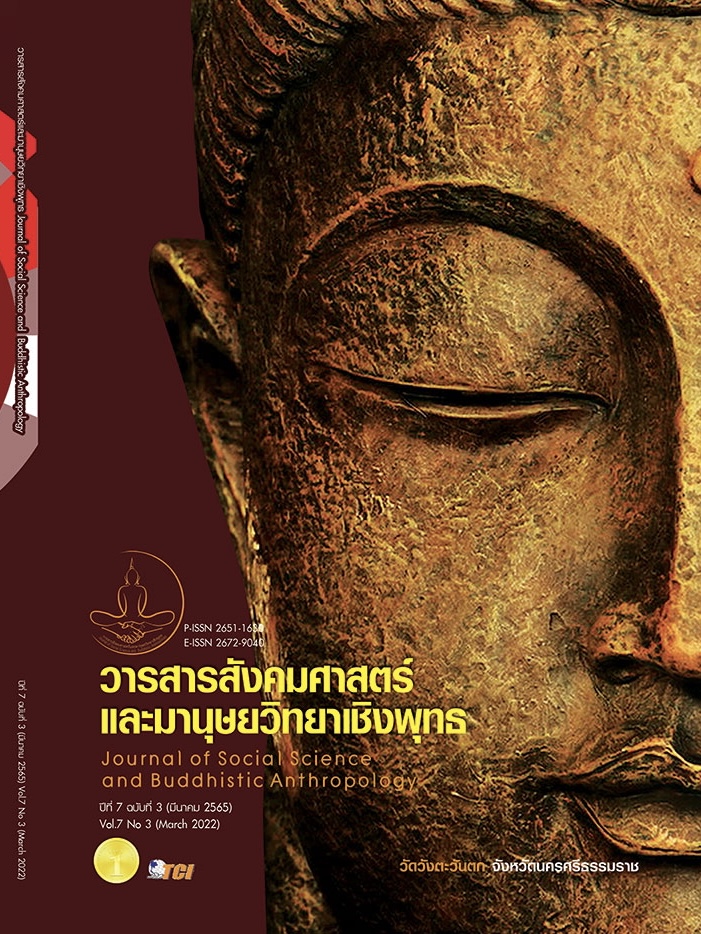BACKGROUND AND KNOWLEDGE OF FOLK PERFORMANCES IN CULTURAL TOURISM IN BURIRAM
Keywords:
Folk Performances, Cultural Tourism Villages, Cultural TourismAbstract
The Objectives of this research article were to study the background and knowledge of folk performances in cultural tourism in Buriram. The researcher used a cultural qualitative research method. The study was documented and fielded with teaching and in-depth analysis on the representative sample 36 people from cultural sites from the 4 tribes of Buriram Province consisting of community leaders Cultural staff from cultural tourism villages and tourists who come to see folk performances and cultural tourism and present data by descriptive analysis. The research findings were as follows: The history of Ban Sanuan Nok cultural tourism village is of Thai-Khmer ethnic group. Ban Khok Muang Cultural Tourism Village is a Thai-Lao ethnic group. Ban Ta Long Cultural Tourism Village is a Thai Kui ethnic group and Ban Khok Wan Cultural Tourism Village is a Thai Korat ethnic group. All 4 villages are mainly agricultural occupations with outstanding cultural diversity. Traditions and rituals invite tourists to experience such diversity. and knowledge of folk performances in cultural tourism villages in Buriram. The past performances misunderstanding of their style. In other words, the person in responsibility of the performances chooses a performances that is a typical performances ,a song that is currently trending or a song with a relatively fast pace to make the performances enjoyable. Making the performances do not unique to their own tribes. And more importantly, the leaders in the show's rehearsals lacked knowledge about the show, making the show not convey the culture of the burning bump as well as it should have.
References
คณะกรรมการพัฒนาการเศรษฐกิจและสังคมแห่งชาติ. (2561). ยุทธศาสตร์ชาติ ระยะ 20 ปี พ.ศ. 2561 - 2580”. กรุงเทพมหานคร: สำนักงานพัฒนาการเศรษฐกิจและสังคมแห่งชาติ.
จารุวรรณ ธรรมวัตร. (2538). วิเคราะห์ภูมิปัญญาอีสาน. มหาสารคาม: มหาวิทยาลัยมหาสารคาม.
ชาย โพธิสิตา. (2549). ศาสตร์และศิลป์แห่งการวิจัยเชิงคุณภาพ. นครปฐม: สถาบันวิจัยประชากรและสังคมมหาวิทยาลัยมหิดล.
ทรงคุณ จันทจร. (2549). การวิจัยเชิงคุณภาพทางวัฒนธรรม. กาฬสินธุ์: ประสานการพิมพ์.
ธีรวุฒิ เอกะกุล. (2543). ระเบียบวิธีวิจัยทางพฤติกรรมศาสตร์และสังคมศาสตร์. อุบลราชธานี: สถาบันราชภัฏอุบลราชธานี.
ประภาศรี อึ่งสกุล และคณะ. (2558). การศึกษาภูมิปัญญาท้องถิ่น กรณีศึกษาการแสดงพื้นบ้านรำวงเวียนครก ของตำบลนาพละ อำเภอเมือง จังหวัดตรัง. ใน รายงานการวิจัย. มหาวิทยาลัยราชภัฏภูเก็ต.
สำนักงานจังหวัดบุรีรัมย์ กลุ่มงานยุทธศาสตร์และข้อมูลเพื่อการพัฒนาจังหวัด. (2559). แผนพัฒนาจังหวัด 4 ปี (ปี 2561- 2564) จังหวัดบุรีรัมย์. บุรีรัมย์:
สุทธิชัย โล่นารายณ์และคณะ. (2561). ยุทธศาสตร์การท่องเที่ยวเชิงบูรณาการของจังหวัดบุรีรัมย์. วารสารวิจัยและพัฒนา วไลยอลงกรณ์ ในพระบรมราชูปถัมภ์, 13(3), 38.
สุภางค์ จันทวานิช. (2542). การวิเคราะห์ข้อมูลในการวิจัยเชิงคุณภาพ. กรุงเทพมหานคร: โรงพิมพ์แห่งจุฬาลงกรณ์มหาวิทยาลัย.
อาจารี รุ่งเจริญ. (2557). การใช้เอกลักษณ์จากศิลปะการแสดงพื้นบ้านเพื่อการส่งเสริมการท่องเที่ยวเชิงวัฒนธรรม : กรณีศึกษาจังหวัดสุพรรณบุรี. วารสารสถาบันวัฒนธรรมและศิลปะ, 16(31), 68-69.
Downloads
Published
How to Cite
Issue
Section
License
Copyright (c) 2022 Journal of Social Science and Buddhistic Anthropology

This work is licensed under a Creative Commons Attribution-NonCommercial-NoDerivatives 4.0 International License.








